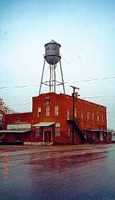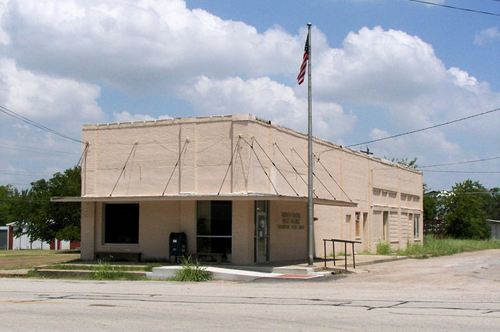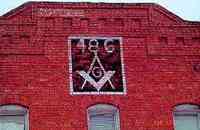Thornton, Texas, Limestone County. (original) (raw)
 |
Thornton watertower TE photo, 2001 |
|---|
History in a Pecan Shell
Thornton was started in 1868, just two years before the railroad came through. In this case it was the Houston and Texas Central Railway. The town's name came from one of the founders, John E. Thornton.
The town grew, although slowly. Besides agriculture, there were brick yards and ceramics manufacturing. The Thornton Institute was started in 1877. This was a college that later became the Thornton School.
In 1890 the population was 460, over twice what it was in 1880. The town incorporated in 1907 and in 1927, just before the stock market crash, Thornton hit its population zenith of nearly 2,000 people. In the first years of the Depression the population fell by more than half. Today the population is 526.

 |
Thorton's Masonic Emblem dates back to 1878. TE photo, 2001 |
|---|
 |
Detail of the Thornton School TE photo, 2001 |
|---|
Historical Marker: E. 8th Street, between N. Marshall and N. Tyler streets
Thornton Schools
Thornton was established in 1871 by the Texas Central Railroad and had a post office by 1873. By 1880, the town had approximately 200 residents and three churches, as well as several businesses and a Masonic lodge. Early schools included the Thornton Male and Female Institute, founded in 1877 by physician and teacher Edward Coke Chambers. The Institute, known also as Thornton College, included a wood-frame classroom building, student housing and Chambers' home. The school received its charter in 1881 and in 1884 merged with the school of Henry P. Davis. In 1889, Chambers sold the Institute to Davis, who continued to operate the school until 1891, when he sold it to the newly formed Thornton Independent School District. In 1903, a storm destroyed the school building, and in 1920, the second school building burned. The third schoolhouse, built of brick, was completed in 1921. During the 1930s and 1940s, several rural districts consolidated with Thornton, including all or part of Mill Creek, Prairie View, Pleasant Grove, Davis Prairie, Beulah and Eutaw Springs common school districts. In the early 1960s, with a declining student population, Thornton began to close its schools. African American students, who had for many years attended a Rosenwald School on Ellis Street, began traveling to Groesbeck for classes, as did the high school students from the White campus. In 1965, Thornton consolidated completely with the Groesbeck Independent School District, stipulating in the transfer that the main school building and grounds at this site be deeded to the city for use as a community center.
(2004)

Steele Creek sign on FM 2749
Photo courtesy Barclay Gibson, August 2006
Thornton, Texas Forum
- Information sought on Death of Baptist Minister near Thornton:
I have an ancestor that lived in the [Thornton] area before Thornton was a town. It was in the 1860s that Reese Alexander Clifton and his in-laws, the Steele Family bought land. Reese was a Baptist minister and in 1872 he was murdered by some local carpet baggers that had taken over the county - so the family history goes. His family continued to live on the family farm until the late 1880s then sold out and moved to Haskell County. We will be in the area in March with other relatives to locate the family farm and cemetery. Any information [anyone] can furnish on the death of Reese Clifton would be appreciated. - Dana Funk, February 7. 2006
Texas Escapes, in its purpose to preserve historic, endangered and vanishing Texas, asks that anyone wishing to share their local history, stories, landmarks and recent or vintage photos, please contact us.